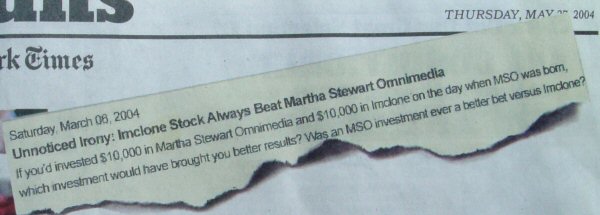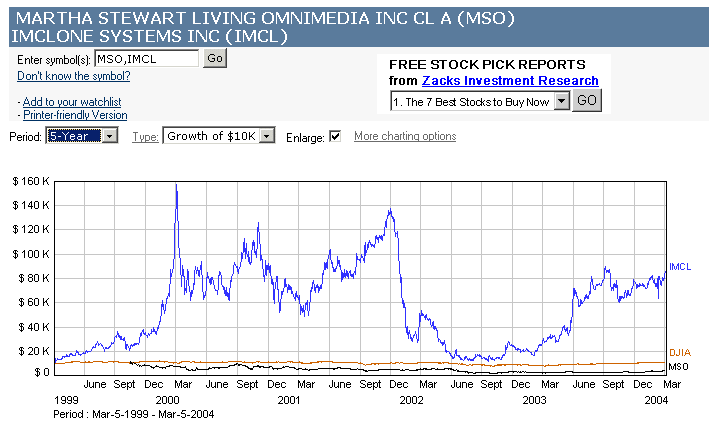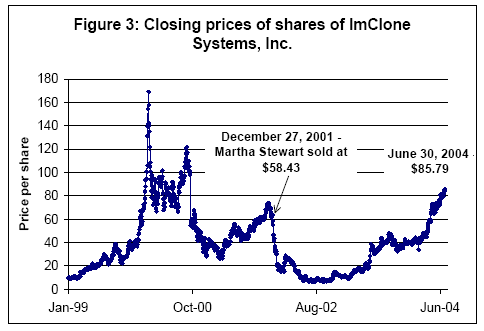 later will, as a matter of etiquette, give credit to the paper that reported the news first. Among academics, it's expected that you'll drop a footnote crediting the original source of an idea you use in your scholarly writings. Where does a blogger go to complain when a major newspaper cites a finance professor whose "working paper" rehashes news his blog broke months earlier?
later will, as a matter of etiquette, give credit to the paper that reported the news first. Among academics, it's expected that you'll drop a footnote crediting the original source of an idea you use in your scholarly writings. Where does a blogger go to complain when a major newspaper cites a finance professor whose "working paper" rehashes news his blog broke months earlier?
On March 6, 2004 I published a piece in Wigblog entitled:
Unnoticed Irony: Imclone Stock Always Beat Martha Stewart Omnimedia
See:
http://wigblog.blogspot.com/2004_03_01_wigblog_archive.html#107859667822454858
I'd read that the FDA approved the drug Erbitux -- the same drug that they disapproved years earlier, leading to the insider trading allegations -- during Martha Stewart's trial. This got me thinking: hmm, how is Imclone stock doing? How has it done since Martha sold her shares? So I spent a couple of hours fiddling with Web stock charting services, and discovered that Imclone stock, while highly volatile, had done just fine since Martha dumped her shares.
In fact, looking carefully, it appeared that Imclone always did better than Martha's own company. So instead of selling when she got the inside tip about the FDA ruling, Martha should have bought Imclone. It turns out Imclone has always beat Martha's own company, MSO.
Now normally not that many folks read my blog, and therefore the world probably little noted nor long remembered my observation. But something funny happened: my blog was prominently profiled in The New York Times on May 27, 2004, and The Times chose to "call out" my Martha story.

After the judge sentenced Martha on Friday, the media decided to pay even more attention to her stock tale. When I picked up Saturday's Detroit Free Press, I was surprised to see a Knight-Ridder article proclaiming:
IMCLONE SHARES: Sale was a money mistake as well
http://www.freep.com/money/business/martha-imclone17e_20040717.htm
The Freep credits the article to Josh Goldstein; some Googling reveals him to be a business writer for the Philadelphia Inquirer, a sister Knight-Ridder paper.

The article quotes one Meir Statman, finance professor at Santa Clara University. [The reporter was sloppy, citing Statman of "the University of Santa Clara, Calif." That's like confusing Harvard University with the University of Harvard.] During her trial, Martha was forced to reveal details of her portfolio, and Statman analyzed her investment patterns and stock performance.
Statman writes: Last, and most ironic, Martha Stewart surely wishes, in hindsight, that she had held on to her ImClone stock. The shares she sold for less than $60 in December 2001 could have been sold for more than $85 at the end of June 2004.
http://lsb.scu.edu/finance/faculty/Statman/articles/Martha%20071204.pdf
It seems that the "unnoticed irony" that I reported in March -- and that The Times quoted in May -- got the notice of this finance prof in July. Hmm, I wonder if he reads The Times? Hmm, here's his e-mail address -- mstatman@scu.edu -- should I write him and ask? Anyhow, I like the chart I made months earlier better than his attempt, because mine depicts Imclone stock versus MSO versus the Dow Jones average all on one chart. First see my chart from March, then his from July:


No comments:
Post a Comment